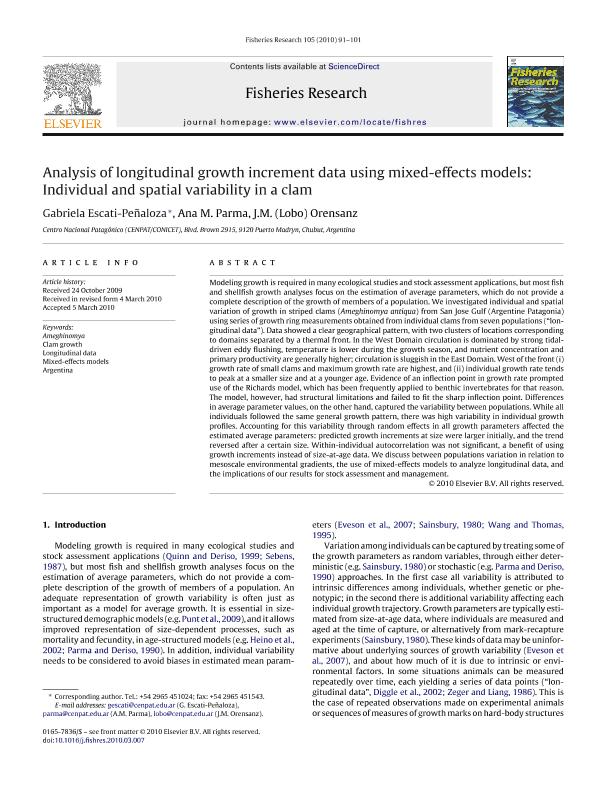Mostrar el registro sencillo del ítem
dc.contributor.author
Escati Peñaloza, Gabriela

dc.contributor.author
Parma, Ana María

dc.contributor.author
Orensanz, Jose Maria

dc.date.available
2018-10-26T14:36:45Z
dc.date.issued
2010-07
dc.identifier.citation
Escati Peñaloza, Gabriela; Parma, Ana María; Orensanz, Jose Maria; Analysis of longitudinal growth increment data using mixed-effects models: Individual and spatial variability in a clam; Elsevier Science; Fisheries Research; 105; 2; 7-2010; 91-101
dc.identifier.issn
0165-7836
dc.identifier.uri
http://hdl.handle.net/11336/63132
dc.description.abstract
Modeling growth is required in many ecological studies and stock assessment applications, but most fish and shellfish growth analyses focus on the estimation of average parameters, which do not provide a complete description of the growth of members of a population. We investigated individual and spatial variation of growth in striped clams (Ameghinomya antiqua) from San Jose Gulf (Argentine Patagonia) using series of growth ring measurements obtained from individual clams from seven populations (" longitudinal data" ). Data showed a clear geographical pattern, with two clusters of locations corresponding to domains separated by a thermal front. In the West Domain circulation is dominated by strong tidal-driven eddy flushing, temperature is lower during the growth season, and nutrient concentration and primary productivity are generally higher; circulation is sluggish in the East Domain. West of the front (i) growth rate of small clams and maximum growth rate are highest, and (ii) individual growth rate tends to peak at a smaller size and at a younger age. Evidence of an inflection point in growth rate prompted use of the Richards model, which has been frequently applied to benthic invertebrates for that reason. The model, however, had structural limitations and failed to fit the sharp inflection point. Differences in average parameter values, on the other hand, captured the variability between populations. While all individuals followed the same general growth pattern, there was high variability in individual growth profiles. Accounting for this variability through random effects in all growth parameters affected the estimated average parameters: predicted growth increments at size were larger initially, and the trend reversed after a certain size. Within-individual autocorrelation was not significant, a benefit of using growth increments instead of size-at-age data. We discuss between populations variation in relation to mesoscale environmental gradients, the use of mixed-effects models to analyze longitudinal data, and the implications of our results for stock assessment and management.
dc.format
application/pdf
dc.language.iso
eng
dc.publisher
Elsevier Science

dc.rights
info:eu-repo/semantics/openAccess
dc.rights.uri
https://creativecommons.org/licenses/by-nc-sa/2.5/ar/
dc.subject
Ameghinomya
dc.subject
Argentina
dc.subject
Clam Growth
dc.subject
Longitudinal Data
dc.subject
Mixed-Effects Models
dc.subject.classification
Otras Ciencias Biológicas

dc.subject.classification
Ciencias Biológicas

dc.subject.classification
CIENCIAS NATURALES Y EXACTAS

dc.title
Analysis of longitudinal growth increment data using mixed-effects models: Individual and spatial variability in a clam
dc.type
info:eu-repo/semantics/article
dc.type
info:ar-repo/semantics/artículo
dc.type
info:eu-repo/semantics/publishedVersion
dc.date.updated
2018-10-12T18:05:15Z
dc.journal.volume
105
dc.journal.number
2
dc.journal.pagination
91-101
dc.journal.pais
Países Bajos

dc.journal.ciudad
Amsterdam
dc.description.fil
Fil: Escati Peñaloza, Gabriela. Consejo Nacional de Investigaciones Científicas y Técnicas. Centro Nacional Patagónico; Argentina
dc.description.fil
Fil: Parma, Ana María. Consejo Nacional de Investigaciones Científicas y Técnicas. Centro Nacional Patagónico; Argentina
dc.description.fil
Fil: Orensanz, Jose Maria. Consejo Nacional de Investigaciones Científicas y Técnicas. Centro Nacional Patagónico; Argentina
dc.journal.title
Fisheries Research

dc.relation.alternativeid
info:eu-repo/semantics/altIdentifier/doi/http://dx.doi.org/10.1016/j.fishres.2010.03.007
dc.relation.alternativeid
info:eu-repo/semantics/altIdentifier/url/https://www.sciencedirect.com/science/article/pii/S0165783610000718
Archivos asociados
